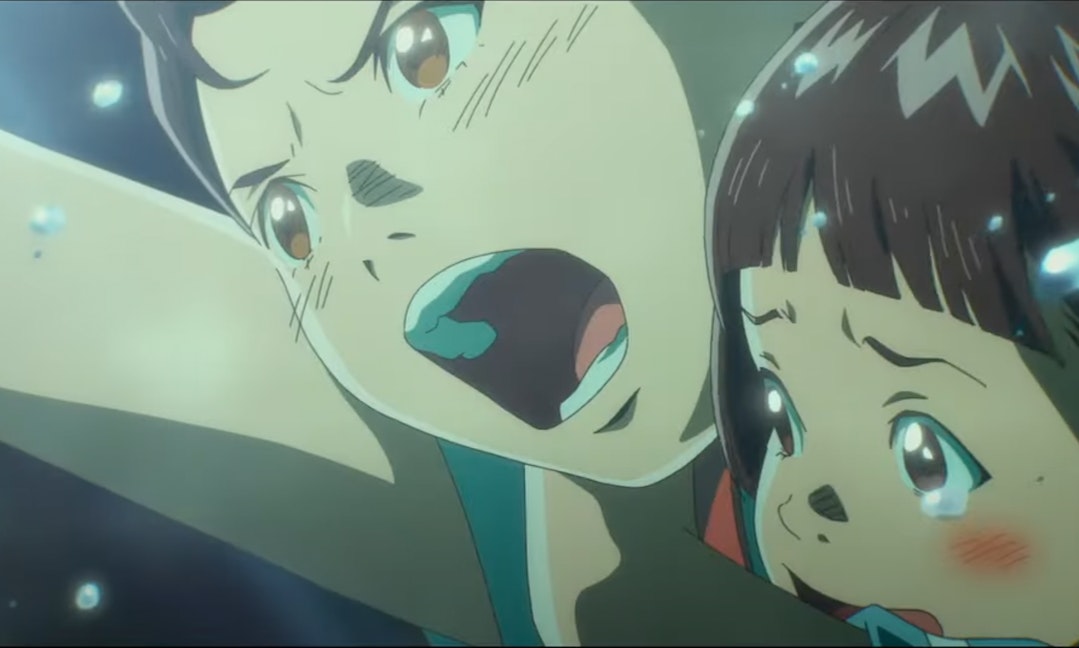
Yoshino Kohei’s Anime Supremacy! (2022) won Best Film at the 35th Nikkan Sports Film Awards, so it’s not just me talking. Adapted by Masaike Yosuke, it takes the intersecting stories of the source novel about three women working in the Japanese animation industry (by Mizuki Tsujimura and illustrator CLAMP) and weaves them into a coherent plot about two anime series vying for ratings dominance, or “supremacy.” Each series has twelve weekly episodes, and each premiere is presented as a round of the competition.
Seven years after Saito Hitomi (Yoshioka Riho) leaves her cushy government job for an animation studio, she’s given the chance to direct her first series. It airs in the same time slot as the sophomore series by Oji Chiharu (Nakamura Tomoya), the genius director of a rival studio whose first series was critically acclaimed for crossing class boundaries. It was that series that convinced Saito, who grew up poor, to change careers.
It’s a classic sports film setup: the reigning champion defending his title against an ambitious underdog who admires the champ. In Oji’s corner is producer Arishima Kayako (Ono Machiko), a former lowly production assistant who was also inspired by him. For her troubles, she now has to corral the unkempt, truant, and writer’s blocked director. Saito’s producer, the aloof and worldly Yukishiro Osamu (Emoto Tasuku) with the slicked back hair, makes every effort to maximize her series’ exposure, sometimes to the detriment of her mental health.
The main selling point, as is the novel’s, is a look into the world of top Japanese animation studios. And we do get a glimpse into the production process, from the director conceiving the shotlist, to the idea pitch meeting, to the dialogue scripting, animation mockups, voice acting, and subcontracted animation finishing. But most of the film focuses on disparate stages, with the whole flow coming together only in a final-act montage (edited by Ueno Soichi; music by Ike Yoshihiro).
The third of the main women is Namisawa Kazuna (Ono Karin), a top animator at a subcontractor who keeps getting begged by both production studios to do more work, often at the last minute. But she, her colleagues, and the studio production staff all do the work in the end, because the two directors are just so passionate about their ideas and the value of leaving a legacy. There are only very brief hints of the toll this takes on their personal lives (both Saito and Oji are loners), and no mention of pay, let alone overtime.
Loving what you do is a great thing; at the same time, animator overwork is a pervasive problem on both sides of the Pacific (google “cg animation overwork” for some horror stories). Passion for one’s work can be management’s excuse for why poor working conditions don’t need to be improved. The sports film genre, with its focus on overcoming the odds through grit and teamwork, has no room to substantively explore this. Yukishiro often reminds Saito that it takes more than being the best to win, but he just means that she should do even more work.
Instead, the film takes on a different aspect of the system. Both directors want to make last-minute changes to the final episode, whose quality often determines home media sales. (Remember home media? You should, as streaming sites start taking down content.) In typical Japanese fashion, both changes insert a note of loss into previously ideal endings; heck, Oji wants to kill off his protagonist. Their producers support them, but the studios are opposed, on the grounds that the shows’ Saturday evening time slot is for children. The directors do it anyway, leading to animator all-nighters. The film stiffs the working class in order to stick it to the man.
Perhaps the characters have been making children’s shows for too long. The plot is often melodramatic in classic anime style, especially when it centers on Saito. She more than once finds herself making emotional declarations despite her shyness; Yoshioka does commendable work with poorly written character moments. At one point, Saito trips and falls while running through a nighttime downpour with no umbrella, soaking her tablet, which she tries to turn on in the rain, fer chrissakes.
Up to the very end, we never get a sense of whose final episode will achieve higher ratings, but by that point, the film has already put both directors in the same structural boat, so the results don’t really matter. That said, the film uses a post-credits scene to eat its cake and have it, too — a cop out.
As for the series themselves, the source of all the brouhaha, we get cliché-riddled snippets with high production values in two different color palettes (both produced by Production I.G.). Some critics lament that we don’t get to see Oji’s first series, the one that made his name; but given what we do see, I think that’s probably for the best.
Anime Supremacy! is part of the 2023 Taipei Golden Horse Fantastic Film Festival.
READ NEXT: ‘John Wick: Chapter 4’ Is a Fitting Conclusion to a Wild Ride
TNL Editor: Bryan Chou (@thenewslensintl)
If you enjoyed this article and want to receive more story updates in your news feed, please be sure to follow our Facebook.







